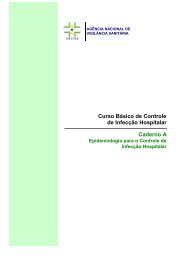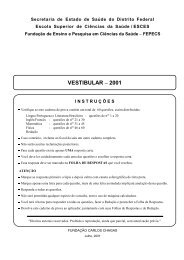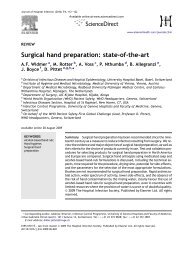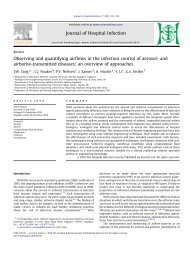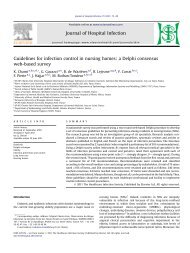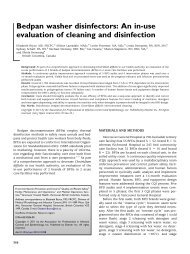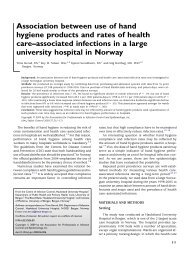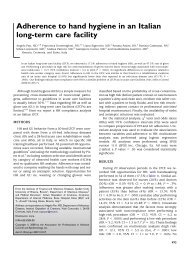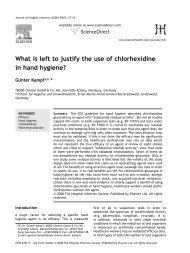Dental unit waterlines: source of contamination and cross ... - CCIH
Dental unit waterlines: source of contamination and cross ... - CCIH
Dental unit waterlines: source of contamination and cross ... - CCIH
Create successful ePaper yourself
Turn your PDF publications into a flip-book with our unique Google optimized e-Paper software.
104 S. Kumar et al.<br />
unrecognised or unreported because <strong>of</strong> the failure<br />
to associate exposure to DUW or aerosols with the<br />
development <strong>of</strong> specific infections. Sporadic infections<br />
such as Pontiac fever, also caused by Legionella<br />
spp., are less likely to be investigated or<br />
notified to health authorities (www.bda.org). 61<br />
Risk factors identified in domestic acquisition <strong>of</strong><br />
Legionnaires’ disease are <strong>of</strong> relevance in preventing<br />
infection in the dental surgery. Multivariate<br />
analysis showed an increased risk <strong>of</strong> infection<br />
following recent plumbing repairs, the use <strong>of</strong> an<br />
electric rather than a gas water heater, smoking,<br />
<strong>and</strong> working >40 h per week. 61<br />
Approaches to risk reduction<br />
DUW cleaning <strong>and</strong> disinfection systems<br />
DUW treatment agents can be introduced into<br />
DUWs from independent reservoir bottles or from<br />
disinfectant delivery devices connected to the DCU<br />
water supply inlet. In the case <strong>of</strong> DCUs connected to<br />
a municipal water mains supply, it is imperative<br />
that the connection is turned <strong>of</strong>f prior to DUW<br />
treatment to prevent <strong>contamination</strong> <strong>of</strong> mains water<br />
with treatment agent. After treatment, DUWs<br />
should be flushed thoroughly using clean water<br />
before DCUs are used for patient treatments.<br />
DCU manufacturers have developed a new generation<br />
<strong>of</strong> DCUs with integrated DUW cleaning<br />
systems that facilitate <strong>and</strong> simplify DUW disinfection.<br />
Indeed other DCU manufacturers are likely to<br />
follow suit, as the dental comm<strong>unit</strong>y becomes<br />
more aware <strong>of</strong> the problem <strong>of</strong> DUW <strong>contamination</strong>.<br />
12,13 WCSä (Water Cleaning System) was<br />
found to be very effective at eradicating DUW bi<strong>of</strong>ilm<br />
in these DCUs when used with Sanosilä (a<br />
highly effective, universally applicable disinfectant<br />
having two main components: hydrogen peroxide<br />
<strong>and</strong> silver) <strong>and</strong> consistently provided<br />
output water with bacterial densities below the<br />
ADA recommended threshold <strong>of</strong> w200 cfu/mL for<br />
up to seven days post disinfection. The microprocessor-controlled<br />
WCS was originally developed<br />
to be retr<strong>of</strong>itted to existing Planmecaä DCUs having<br />
a mains water supply. Some DUWs contain a microprocessor-controlled<br />
system where <strong>waterlines</strong><br />
are filled with disinfectant <strong>and</strong> subsequently automatically<br />
flushed with clean water during the disinfection<br />
cycle. If the cycle is not completed<br />
properly or a power failure occurs during the cycle,<br />
an error message is displayed on the DCU instrument<br />
console. 13,62 While this error message is<br />
displayed, all DCU functions are locked, preventing<br />
the DCU from being used. The WCS is semi-<br />
automated <strong>and</strong> requires the operator to fill the<br />
disinfectant container with disinfectant, to turn<br />
<strong>of</strong>f a valve on the mains water supply <strong>and</strong> to place<br />
DCU instrument hoses into special receivers. DUW<br />
cleaning is activated from a keypad on the DCU<br />
control console <strong>and</strong> disinfectant is automatically<br />
fed into each DUW. Following this the DCU electrical<br />
supply is switched <strong>of</strong>f to allow the disinfectant<br />
in situ to take effect. When the electrical power is<br />
turned back on, a code message on the DCU control<br />
console display prompts the operator to flush<br />
the DUWs. This is initiated by disconnecting the<br />
disinfectant container module <strong>and</strong> turning on the<br />
mains water supply switch. The longer-term<br />
goal should be for fully automated disinfection systems<br />
that are validatable. Recently Planmeca<br />
developed a more advanced microprocessor-controlled<br />
DUW cleaning system called the Water Management<br />
System (WMS), a fully integrated <strong>and</strong><br />
automated DUW cleaning system that requires<br />
minimal effort on the part <strong>of</strong> the operator. The<br />
WMS is more advanced <strong>and</strong> automated than the<br />
WCS <strong>and</strong> also contains many additional features,<br />
including an air gap.<br />
Anti-retraction valves <strong>and</strong> retrograde<br />
aspiration <strong>of</strong> oral fluids<br />
The implicated <strong>source</strong> <strong>of</strong> <strong>contamination</strong> was reaspiration<br />
<strong>of</strong> fluid from the oral cavity that<br />
occurs when negative pressure is generated on<br />
stopping equipment. Recently, molecular techniques<br />
were employed to demonstrate the recovery<br />
<strong>of</strong> viral particles <strong>and</strong> human DNA in<br />
<strong>waterlines</strong> servicing the air turbine <strong>and</strong> prophy<br />
angle h<strong>and</strong>piece. 63 Anti-retraction valves (also<br />
known as check valves) will limit re-aspiration<br />
<strong>and</strong> are most efficacious when fitted immediately<br />
distal to the h<strong>and</strong>piece. As with any component<br />
<strong>of</strong> the water supply line they are subject to clogging<br />
due to bi<strong>of</strong>ilm deposition <strong>and</strong> fatigue. In order<br />
to ensure adequate mechanical functioning,<br />
they require regular maintenance <strong>and</strong> programmed<br />
replacement. Autoclaving <strong>of</strong> h<strong>and</strong>pieces<br />
after use <strong>and</strong> flushing <strong>of</strong> <strong>unit</strong>s for 30 s at the end<br />
<strong>of</strong> patient treatment <strong>and</strong> for 2.5 min at the end<br />
<strong>of</strong> the day will augment the action <strong>of</strong> the anti-retraction<br />
valve <strong>and</strong> should help to eliminate any<br />
aspirated fluid. 64 Some manufacturers have incorporated<br />
anti-retraction valves within the h<strong>and</strong>piece<br />
design, permitting autoclaving <strong>of</strong> the<br />
valve between patients. Backflow from dental<br />
<strong>unit</strong>s to the mains water supply may occur <strong>and</strong><br />
it may be necessary to install check-valves to<br />
prevent this occurring. 65



